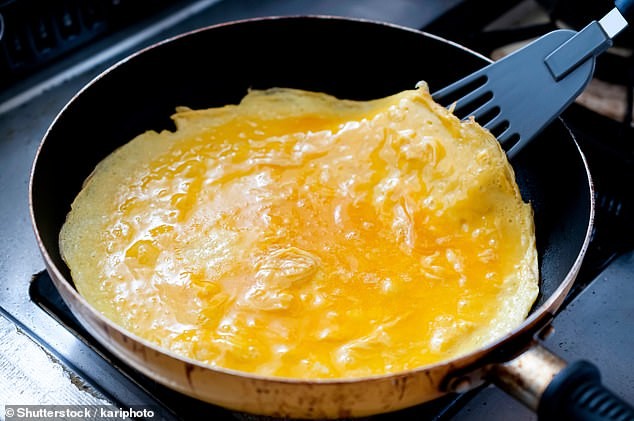You've been making your omelettes all wrong! Chef reveals easy technique to stop eggs from burning and breaking
A Michelin-starred chef has revealed the secret for making the ultimate omelette — and it's not as complicated as you think. Paul Foster, a Coventry-born chef whose former restaurant Salt earned a Michelin star in 2018, revealed his trusted method for mastering the classic egg dish. The following insights come straight from his advice and demonstrations. As he explains the process, you’ll hear his own words guiding the technique: "If it just melts it's not hot enough, if it starts to brown straight away it's too hot. Reduce the heat as the omelette comes together," he explained. "Only add salt just before cooking," he said, explaining that it's important that the egg mixture does not sit in salt since it 'will break down the proteins in the egg and affect the texture if added too early.' "I use butter, but you can also add a neutral oil like sunflower or vegetable to help prevent the butter from burning," he said. The chef also notes that the pan should be the right size: "If it is too small, the egg will not cook evenly and will be difficult to roll, but if it is too big, it may not cook quickly enough." He adds that the perfect number of eggs is three per omelette, explaining that regardless of size, two wouldn't be enough and four too many. Paul also emphasizes that the combining of the eggs is a vital step often misjudged by people at home. He says: "Don’t overbeat your eggs, whisk until combined. If you overdo it, it will get foamy and add too much air, affecting the final texture." To avoid the omelette tearing, he advises leaving the mixture to rest for around 10 to 15 seconds and then to practice folding rather than flipping. "This should be done when the omelette is set as one piece but the top is still slightly runny and soft, use a spatula to fold one side into a third, then into a third again to create a rolled effect, then carefully turn onto a warm plate so the fold line is on the bottom. "And if folding feels risky, serve it open – no shame in avoiding the scramble," he added. Finally, cooks opting for a cheese filling should be sure to use a fine grater for an even distribution throughout the dish. "Most fillings are best going in at the end just before folding as it will be much easier to get an even finish and help prevent cracks when rolling," he said. To add a final flourish, cooks can rub a knob of butter over the surface to add a 'luxurious glaze'. Additionally, a 'garnish of chopped herbs like chives or dill and a fine grating of lemon zest can really bring it to life,' he said. "Alternatively, for texture contrast, add some crisps or lightly toasted panko breadcrumbs, other great flavour additions could be pickled red onions and a spoonful of crème fraiche."

In This Article:
- The method that delivers perfection: heat, salt, fat and fold explained in one masterclass
- From studio to stove: how the expert folds, fries and finishes an omelette
- When to fold open or roll up your omelette the smart way
- The chef’s journey from Salt to YouTube and what lies ahead
- A complete recipe snapshot for two: omelette and salad
The method that delivers perfection: heat, salt, fat and fold explained in one masterclass
A Coventry-born chef, Paul Foster, spoke about his trusted method for mastering the omelette. He emphasizes: Heat a non-stick pan over medium heat before adding a knob of butter. "If it just melts it's not hot enough, if it starts to brown straight away it's too hot. Reduce the heat as the omelette comes together," he explained. "Only add salt just before cooking," he said, explaining that it's important that the egg mixture does not sit in salt since it 'will break down the proteins in the egg and affect the texture if added too early.' Using the right kind of fat is also important: "I use butter, but you can also add a neutral oil like sunflower or vegetable to help prevent the butter from burning," he said. The pan should also be the right size. If it is too small, the egg will not cook evenly and will be difficult to roll, but if it is too big, it may not cook quickly enough. The perfect number of eggs is three per omelette, he said, explaining that regardless of size, two wouldn't be enough and four too many. Paul said the combining of the eggs was a vital step often misjudged by people at home. He said: "Don't overbeat your eggs, whisk until combined. If you overdo it, it will get foamy and add too much air, affecting the final texture."

From studio to stove: how the expert folds, fries and finishes an omelette
To avoid tearing, the chef advises resting the mixture for about 10 to 15 seconds and then practicing folding rather than flipping. "This should be done when the omelette is set as one piece but the top is still slightly runny and soft, use a spatula to fold one side into a third, then into a third again to create a rolled effect, then carefully turn onto a warm plate so the fold line is on the bottom. "And if folding feels risky, serve it open – no shame in avoiding the scramble," he added. For cheese fillings, use a fine grater for even distribution. Most fillings are best going in at the end just before folding as it will be much easier to get an even finish and help prevent cracks when rolling. To add a final flourish, rub a knob of butter over the surface to add a 'luxurious glaze'. Garnish with chopped herbs like chives or dill and a fine grating of lemon zest to bring the omelette to life. "Alternatively, for texture contrast, add some crisps or lightly toasted panko breadcrumbs, other great flavour additions could be pickled red onions and a spoonful of crème fraiche."

When to fold open or roll up your omelette the smart way
British Lion Eggs, in a new study, found omelettes to be the most popular breakfast for 2025. The study noted: - Omelettes are the most popular breakfast for 2025 according to British Lion Eggs. - More than half of those surveyed admitted omelettes were one of the hardest dishes to master. - Two thirds said they'd faced kitchen disasters while trying to perfect the technique, with complaints of burnt pan bottoms, overstuffing and overly dry final products. - Cheese was the most popular filling (79 per cent selected it as their favourite). - Other fillings included ham, mushrooms, onions and tomatoes, with some cooks adding crisps or panko breadcrumbs. - Serving preferences varied: 38 per cent with a fresh green salad, 32 per cent with oven chips, 20 per cent with bread, and others with tomato salad or dipping sauces.

The chef’s journey from Salt to YouTube and what lies ahead
Paul Foster was once the owner of Salt, a Stratford-upon-Avon-based eatery that earned its first Michelin-star in 2018. After eight years of trading, he announced earlier this year that he was having to close the venue earlier amid cost-of-living pressures on customers. Revealing his next steps in a video posted to social media, he unveiled his new YouTube channel, called Food Unfiltered, where he will share stories from his career as a chef. "British Lion eggs make the perfect base for an omelette and serving it open means it's much easier to cook accurately, as you can avoid the difficult rolling in the pan. The ham adds a salty delicious fattiness to the eggs (I like using Coppa ham, but prosciutto will work too), which is freshened up by the sweet sharp tomato salad. Tomatoes are best in season, and I prefer to use Isle of Wight tomatoes for this dish when I can."

A complete recipe snapshot for two: omelette and salad
Ingredients Serves 2 to share Omelette Salad Method Cut the tomatoes in half, slice the shallot thinly, and slice the courgette into 5 mm rounds. Place all the ingredients into a bowl. Add the vinegar, oil, pinch of salt and a twist of black pepper. Mix gently and leave to sit for 5–10 minutes for the vegetables to lightly cure. Cut the core off the chicory and separate the leaves, wash in cold water, drain and keep to one side. Crack the eggs and beat well in a bowl until there are no traces of the white, season with salt and pepper. Stir in the tarragon. Heat a large non-stick pan on a medium to high heat, add the oil and the butter and bring to a gentle foam without colour. Add the egg to the pan and stir with a spatula, working the set curds into the centre, whilst allowing the omelette to form again between stirring. For the perfect baveuse finish turn off the heat when there is still a soft liquid on top of the egg, yet it is still holding its form. Release the edges of the omelette from the sides of the pan, carefully place the slices of ham on top spread evenly and allow them to warm gently. Carefully slide the omelette onto a warm large plate and add the rocket on top. Mix the chicory through the tomatoes and serve in a bowl on the side.

